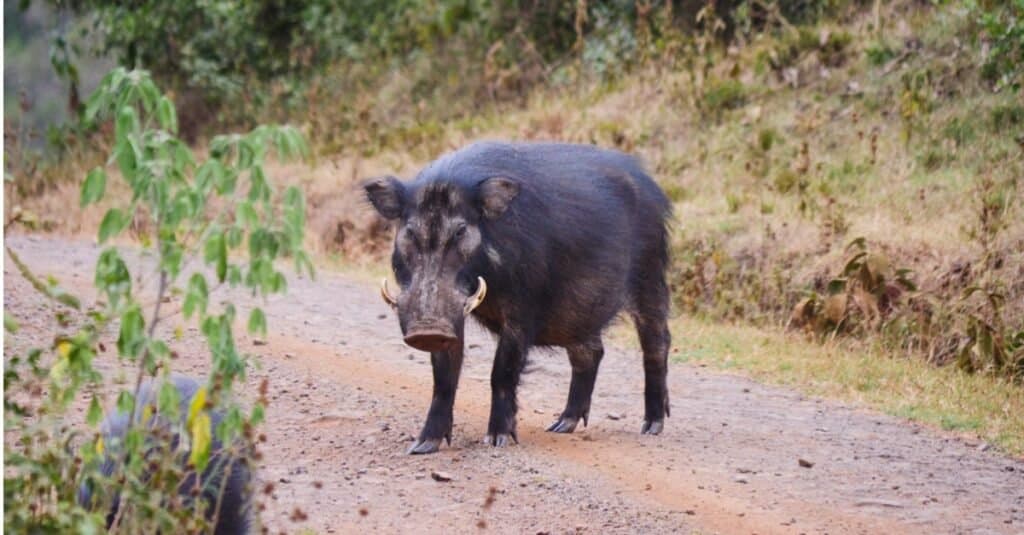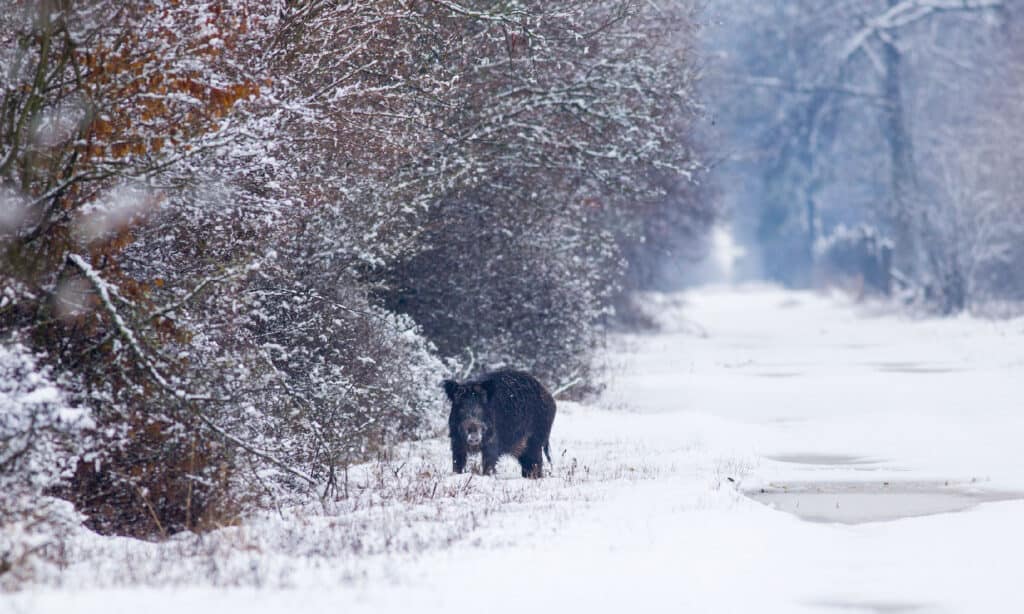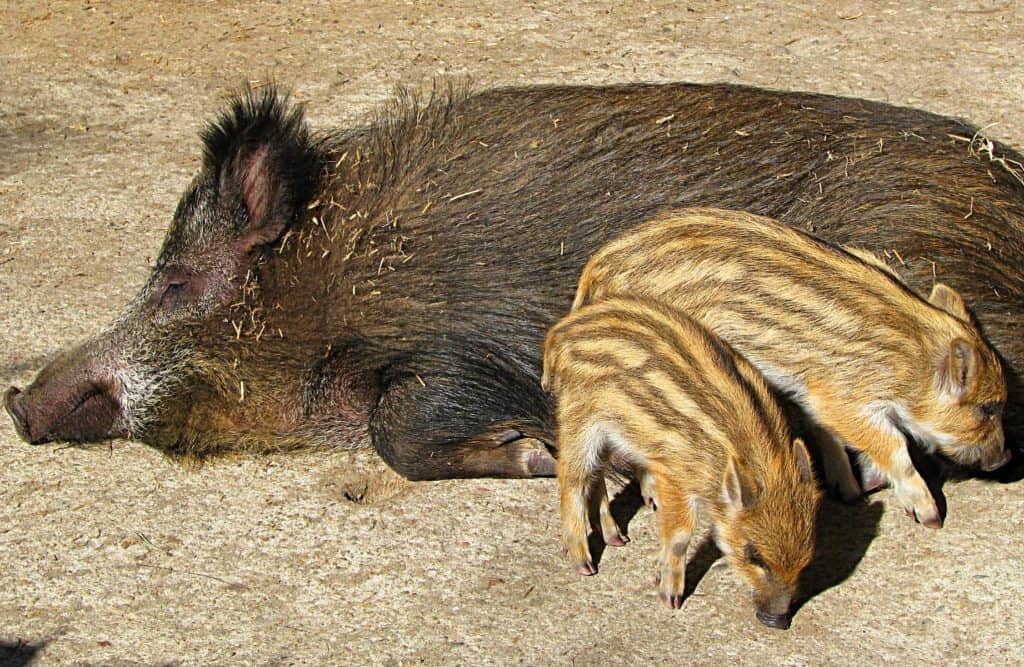Feral pigs are one of the most destructive, if not the most destructive, invasive species in the United States today. They reside in 40 out of the 50 states and may number as many as nine million. And their populations show no signs of declining. Feral swine uproot vegetation and pollute water supplies, driving away other species. They eat ground-dwelling small mammals, reptiles, birds, and eggs. Wild boars eat almost any crop, root under fences to get onto property, and leave holes for livestock and pets to escape. They carry disease, are aggressive, and have a nasty bite. Farmers are trying various methods to get rid of them, but it’s an uphill and expensive battle. But one thing’s for sure, feral pigs are destroying farms and the cost of doing nothing will far outweigh the cost of taking action.

Invasive wild boars have been spotted in 40 of the 50 states.
©iStock.com/chingkai huang
Who’s to Blame for Pigs on the Loose?
Whatever you want to call them – feral pigs, feral hogs, wild pigs, wild hogs, razorbacks, or wild boars – blame Christopher Columbus. He and his crew brought domestic swine to the Western Hemisphere and deliberately released them to multiply in the wild as a food source for future adventurers and colonists, so they wouldn’t have to bring as many supplies with them. Other explorers followed their example until feral pig populations were established on many of the islands of the Caribbean and the North American continent. As time went on, domestic pigs on colonial farms escaped into the wild from time to time, further bolstering the size of feral herds. Today, they’re a continent-wide problem numbering in the millions. Of the 40 U.S. states where they live, these 10 have the largest feral hog problem:
- Texas (3 million)
- Oklahoma (1.5 million)
- Louisiana (750,000)
- Georgia (600,000)
- Florida (500,000)
- New Mexico (500,000)
- South Carolina (450,000)
- California (400,000)
- Hawaii (400,000)
- Alabama (250,000)

Feral pigs originated with swine released by early explorers on Caribbean islands and the North American mainland.
©Simon Dannhauer/Shutterstock.com
What’s So Bad About Them? Aren’t They Kinda Cute?
Sure, they’re cute, but they’ll bite your fingers off and gore your dog with their tusks. Wild boar can be vicious toward other wild animals, people, or pets, especially during mating season or when defending their territory or offspring. Studies have shown they can carry as many as 34 diseases that can be passed on to animals or people through bites, close contact, eating their meat or drinking water they have polluted. A particularly serious concern for pig farmers is that feral populations will spread swine flu, a respiratory infection that is fatal to pigs and was finally eradicated with a great deal of effort and expense in 1978.
Feral hogs damage the environment greatly just as they live their piggy lifestyles. Sure, rooting around with your nose in the mud can turn up tasty roots, bulbs, grubs, and the occasional ground-dwelling mole or rat for your protein needs. And yes, on a hot day, nothing beats wallowing in the ‘ol water hole. But here’s the thing. Some of those plants and animals are endangered species – unlike pigs. And hogs literally turn the forest into a pigsty where plants can’t get rooted without being trampled or snuffled up and other species flee before they turn into lunch.
They wade and wallow in other animals’ drinking water, which pollutes it with mud, feces, and bacteria. Fish, along with other water-dwelling animals, don’t care for this behavior. Research shows that forests frequented by feral swine have an average 26% decline in biodiversity, as other species are either consumed or forced to roam elsewhere in search of food and a place to live and reproduce without being vacuumed up by insatiable hogs. They just aren’t good roommates for anyone but other pigs.

Wild boars are omnivores that will literally eat
anything.©iStock.com/JMrocek
But Don’t Farmers Like Pigs?
Well, yes, a nice pig can be a good thing to have around to eat the table scraps and one day make the ultimate sacrifice to give the farmer a couple of months’ worth of ham sandwiches and sausage breakfast burritos. But wild pigs? Not so much. They do the same things to the farm that they do to the forest:
- They eat any crop: grains like sugar cane, corn, soybeans, peanuts, and rice; and fruits and vegetables like pumpkins, melons, lettuce, spinach, or carrots.
- They root up pastures to eat grubs and roots, destroying valuable grazing plants that are often replaced with more hardy weeds.
- They rub against trees and vines to remove parasites from their skin and use their tusks to scrape bark off trees to mark territory. This can damage fruit trees and vineyards and create openings for diseases, fungi, and parasites to invade areas of stripped bark.
- Ruts in pastures and fields create rough and muddy terrain that livestock may slip or trip in and make driving a tractor to harvest a field harder.
- Wild pigs can transmit disease to livestock and can kill young calves and lambs. They eat livestock feed and contaminate water supplies.
- Feral swine sometimes break irrigation lines, rip nets, trellises, and drying racks, and root under fences or break them down.
All of this costs farmers money. Big money. The U.S. Department of Agriculture’s Animal and Plant Health Inspection Service estimates feral pigs do $1.5 billion in damage every year to farms across the country. So the big question is, how do we stop them?

Feral pigs are not just a southern problem. They’ve even been seen in Canada!
©iStock.com/Jevtic
“De-Pigging” Strategies
So what’s being done to “de-pig” the areas worst hit by the feral hog invasion? Here are some of the strategies being used, with pros and cons of each.
Hunting
Many states have a hunting season for wild pigs. Some people even hunt them from helicopters.
Pros: Permanently eliminates specific animals and their breeding potential. Properly prepared, boar meat can be eaten.
Cons: Hunting can drive feral hog populations onto other property that may be even more delicate and vulnerable to destruction, or across state borders to an administration that may not be as prepared to deal with them. Wild pig meat must be prepared with great attention to health standards to prevent the spread of disease.
Fencing
Specially-designed fencing with 3-4 strands of electric wire set to 16 joules or more and woven wire fencing with barbed wire at the bottom to prevent rooting can keep pigs out of designated areas.
Pros: Can work for a long time on a lot of animals.
Cons: Requires time and money to install and maintain.
Trapping
Special traps for feral pigs can be set in areas they frequent.
Pros: Traps work day and night without continual monitoring, so they are less time-intensive than hunting.
Cons: Depending on the type of trap, it is possible to unintentionally capture other animals. Check traps regularly to prevent animal suffering and keep them freed up for their next catch.
Poisoning
Poison-laced feed can be left out for feral pigs.
Pros: That pig and its potential descendants will no longer be an issue.
Cons: Can inadvertently poison other species, including those who might feed on a poisoned pig carcass.
Sterilization
Contraceptive-laced hog feed is left out in wild pig territory to lower the sperm count in feral boars.
Pros: It doesn’t kill, so animal lovers go hog-wild for it. Conservationists can put it in special feeders designed so other species can’t access it.
Cons: Only lasts for 30 days.

Contraceptive-laced hog feed can help cut down on feral pig reproduction.
©Jarosław Pocztarski / CC BY 2.0 – License
Clearly, there is no one method of dealing with this problem that’s a magic bullet. Some combination of methods is probably the best way to deal with a problem that shows no signs of letting up and that creates huge costs for farmers and the natural ecosystem.
The photo featured at the top of this post is © Slatan/Shutterstock.com
Thank you for reading! Have some feedback for us? Contact the AZ Animals editorial team.







